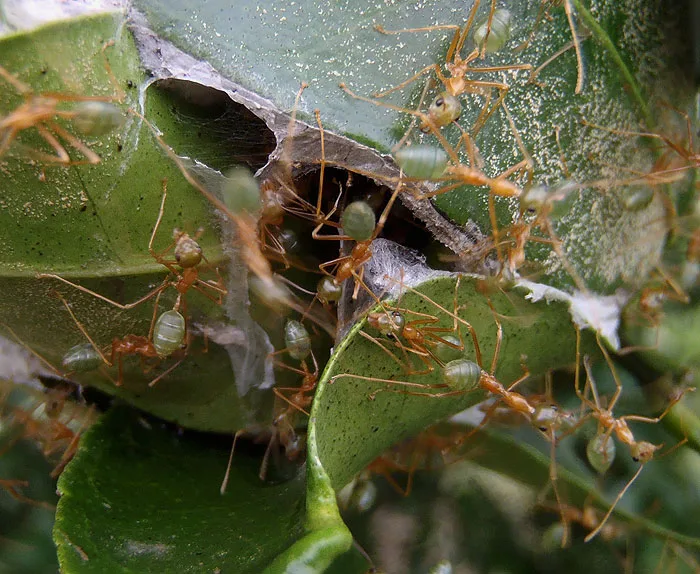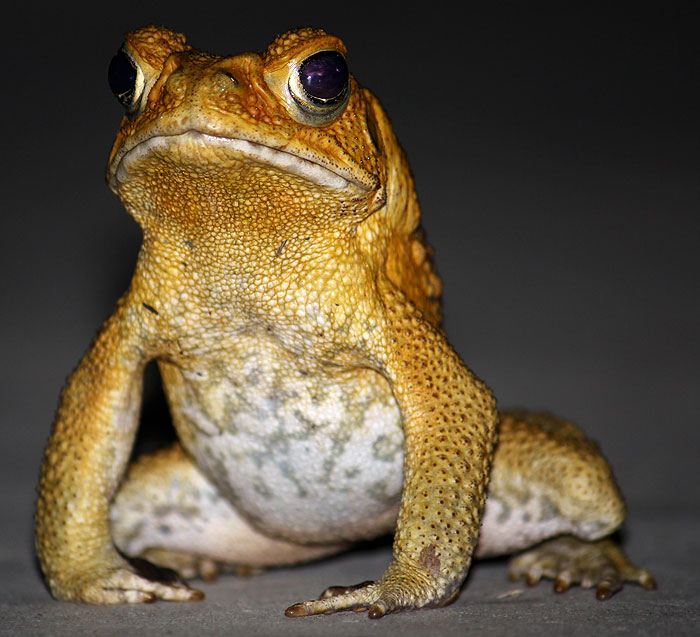Weaver or Green Tree Ants
No backyard wildlife blog in Northern Australia would be complete without the inclusion of these incredibly interesting little ants. They're locally known as Green Tree Ants but in other places throughout the world they have the far more intriguing name of Weaver Ants.
I mentioned in a former post that we had been inundated with the queens of this species. I put it down to the lack of rain - and so far I haven't come up with a better reason for so many of their number to be around. Anyway, I've watched as some nests have flourished while others have been plundered and rendered barren.
The Queen in the picture below was valiantly attempting to start her own colony - she didn't succeed. I have no idea what predator was her undoing ... but the next couple of days after taking this pic, she and her young were gone.
Weaver Ants are extremely interesting to watch. They are predatory but also farm honey dew producing insects. I have seen nests larger than basketballs and unfortunately for me, I have been on the receiving end of thousands of bites from these pugnacious little critters over my time working in the bush. The discomfort of the bite is exacerbated by the clever use of formic acid which the ants liberally spray into any wounds created by their mandibles. Believe me a Weaver ant bite to the nipple brings a tear to the eye of even the hardiest bushman.
Watching weaver ants build is really one of those - stop and put the camera down type deals. It seems haphazard and there is a confusion of toing and froing with mandibles clashing and much startled raising of antennae ... but build they do. And the structures are really quite awe-inspiring.
The ants build by using their mandibles to manipulate leaves into position while other ants use their pupae to weave a silk - binding the leaves together forming a water tight yet breathable structure.
Weaver ants, like many of their cousins work, live and die as a collective (insert we are the borg here). Any individual, other than the Queen (up to a point), is hard-wired to work for the 'greater good' ... it's sort of like investment banking; individuals simply don't matter - unless you're at the top.
A glimpse into the inner sanctum ... eggs and larvae in different stages of development are obviously housed together - smaller ants tend to their needs while their more robust sisters stand ready to defend the nest.
Small they may be - but they will vigorously attack any animal foolish enough to disturb them - believe me when I tell you that with a few dozen of these ants inside your clothes, size becomes very relative indeed.
I mentioned in a former post that we had been inundated with the queens of this species. I put it down to the lack of rain - and so far I haven't come up with a better reason for so many of their number to be around. Anyway, I've watched as some nests have flourished while others have been plundered and rendered barren.
The Queen in the picture below was valiantly attempting to start her own colony - she didn't succeed. I have no idea what predator was her undoing ... but the next couple of days after taking this pic, she and her young were gone.
 |
Winged queen |
 |
If you look closely between her thorax and abdomen you can see one of her precious eggs |
Weaver Ants are extremely interesting to watch. They are predatory but also farm honey dew producing insects. I have seen nests larger than basketballs and unfortunately for me, I have been on the receiving end of thousands of bites from these pugnacious little critters over my time working in the bush. The discomfort of the bite is exacerbated by the clever use of formic acid which the ants liberally spray into any wounds created by their mandibles. Believe me a Weaver ant bite to the nipple brings a tear to the eye of even the hardiest bushman.
 |
I think this ant may have a discarded pupae skin in her mandibles |
Watching weaver ants build is really one of those - stop and put the camera down type deals. It seems haphazard and there is a confusion of toing and froing with mandibles clashing and much startled raising of antennae ... but build they do. And the structures are really quite awe-inspiring.
 |
The lass at the bottom of the frame is undoubtedly the foreman - in the wrong place and not helping at all |
The ants build by using their mandibles to manipulate leaves into position while other ants use their pupae to weave a silk - binding the leaves together forming a water tight yet breathable structure.
 |
Communication is pheromonal - but if you're injured or weak, It means death. |
Weaver ants, like many of their cousins work, live and die as a collective (insert we are the borg here). Any individual, other than the Queen (up to a point), is hard-wired to work for the 'greater good' ... it's sort of like investment banking; individuals simply don't matter - unless you're at the top.
 |
Repairs and extensions are endless |
A glimpse into the inner sanctum ... eggs and larvae in different stages of development are obviously housed together - smaller ants tend to their needs while their more robust sisters stand ready to defend the nest.
 |
For many small animals - this view is their last |
Small they may be - but they will vigorously attack any animal foolish enough to disturb them - believe me when I tell you that with a few dozen of these ants inside your clothes, size becomes very relative indeed.
 |
The blurry spot on the lens is actually formic acid - brave and fascinating little critters |
The weaver ants belong to the ant genus Oecophylla (subfamily Formicinae) which contains two closely related living species: O. longinoda found in Sub-Saharan Africa and O. smaragdina found in southern India, southeast Asia, and Australia. They are provisionally placed in a tribe of their own, Oecophyllini
The weaver ant genus Oecophylla is relatively old, and 15 fossil species have been found from the Eocene to Miocene deposits
The weaver ant genus Oecophylla is relatively old, and 15 fossil species have been found from the Eocene to Miocene deposits






Comments
Dave
Post a Comment